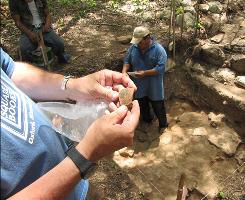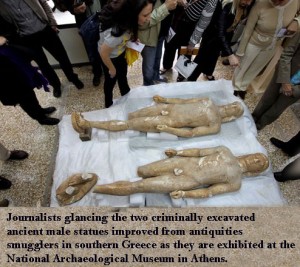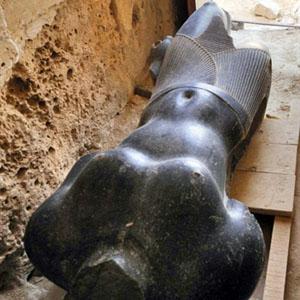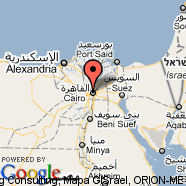Daer Excavation Update
We’ve now completed a few more sites and a new one; no. 104 was only discovered last weekend and we have already excavated 9 square metres of it.
This new site is only a few metres away from site No100 which we started a couple of weeks ago and are still progressing – No 100 has produced chert, flint and pitchstone, and also a couple of nice microliths, the pitchstone means there is a Neolithic aspect to it and the microliths clearly indicate the Mesolithic. The new location – Site 104 – has produced a lot of nice flint, mostly honey coloured and struck from beach pebbles. We know this as there have been lots of pebble fragments with cortex.
Initial thinking is that this site is Neolithic judging by the size of the flint; however we have now found eight microliths from the same area, so maybe it’s another mixed Mesolithic and Neolithic like the nearby Site 100.
At No 104 we have found a feature which initially looked like a fireplace, but after closer inspection, it looks more like a cooking pit, with lots of charcoal and burnt stones intermixed. Four stakeholes in a rough line were also excavated and amazingly one still had the carbonised remains of a stake in it! So that will be subject to identification and dating.
Site 100 and 104 may not relate to each other despite their close proximity because chert dominates at No100 and in No104 chert is almost absent.
One of the many highlights so far is the discovery of Haematite, a maroon coloured soft iron ore, which when rubbed gives a reddish/maroon colour. Some pieces are faceted by grinding and have striae showing that they have been used, presumably as a colouring agent. Recently in Orkney, Neolithic stone walling was found to have been coloured by haematite. At Daer, we are uncertain whether our haematite, which is sealed below peat, dates to the Mesolithic or the Neolithic as it comes from sites with both periods represented. Either way, it is a significant discovery.
The same type of haematite was used extensively on post medieval sites such as bastle houses and we have recorded numerous instances of this, we presume it was used as keel on these sites in the 17th and 18th centuries. We have not been able to source the haematite but now we have found it in a pre historic context and in the same general area, we are assuming it must have been gathered from somewhere locally in Upper Clydesdale.
Source from : http://www.biggararchaeology.org.uk/news26_270411.shtml
Archaeologist George Bey examines a shard of pottery found buried in the floor of a home at Kiuc.
Archaeologists discover new clues why the Maya left: Bird calls ring from the forest, echoing in the middle of the breakdown ruins whose gloomy doorways have long beckoned explorers and scholars.
The Maya who built the ruins of Kiuic here fled those doorways in a rush, an international archaeology team now realizes. Left behind may be frozen-in-time clues to the mythical collapse of their civilization.
The ancient Maya fled Kiuic, nestled in the Puuc (pook) foothills of the Yucatan, around 880. “Things were going full-bore, construction was underway. And things stopped,” Bey says.
Archaeologist George Bey of Millsaps College in Jackson,Miss arise a question: Why did they leave? And he also added the ancient Maya fled Kiuic, nestled in the Puuc foothills of the Yucatan, around 880. “Things were going full-bore, construction was underway”.
Archaeologists have explored Kiuic’s ruins for more than a century, but working since 2000, George Bey and colleagues are now reporting the first evidence of this rapid desertion. USA TODAY was invited to the site to see what has been exposed in the most recent excavations.

Maya populated the lowland forests of Central America during Europe’s Dark Ages, build a civilization of pyramids, palaces and slash-and-burn “milpa” farms made by flaming trees and planting seeds in the ash. Maya rulers oversaw city states that warred with one another, created detailed calendars and lasted centuries. The abandonment of those monument scattered centers stands as one of archaeology’s most-debated mysteries. The “collapse” was underway in modern-day Guatemala by 800, but didn’t take place at Kiuic until almost a century later.
At Kiuic, “the evidence for rapid abandonment now appears more compelling,” says archaeologist Takeshi Inomata. Kiuic has been visited by archaeologists since at least 1841, when John Lloyd Stephens, recorded the site for his Incidents of Travel in Yucatan. During excavations last year, archaeologists found pottery and stone tools left in place inside homes, including a wealthy farmer’s kitchen room perched on the edge of the hill.
Kiuic’s population boomed, reaching perhaps 4,000 inhabitants, just as the centers more than 200 miles farther south
The team will keep on raising questions with each new bit of evidence, aiming to uncover clues to Kiuic’s collapse and the wider fall of a civilization.
Greek police seize 2 statues from 2 farmers, which date between 550 and 520 BC, and trying to trade them to a overseas buyer for euros 10 million.
Greece — Police in southern Greece have apprehended a rare twin pair of 2,500-year-old marble statues and arrested two farmers who supposedly planned to sell them abroad for euro10 million ($12.43 million), authorities said Tuesday.

Police said two Greeks aged 42 and 48 were arrested in the Peloponnese region late Friday as they were loading the criminally excavated figures of young men into a truck. Authorities are seeking a third man alleged of belonging to a smuggling gang that planned to spirit the 6th century B.C. works out of the country.
“This is a very significant find, of fabulous value, and (both statues) were ready to be taken out of Greece,” Culture Minister Pavlos Geroulanos said.
Archaeologists said Tuesday the statues are “exceptional works of art” and may have come from a temple or cemetery in a lost ancient city in the Peloponnese area in southern Greece. Both are in outstanding condition, but lack sections of their lower legs and were gashed by a plow or digging machinery.
They stand 1.82 meters (5 feet 9 inches) and 1.78 meters (5 feet 8 inches) high, and were perhaps carved by the same sculptor out of thick-grained island marble between 550-520 B.C, at the height of the archaic period of sculpture.
“They are accurately the same, with an unimportant variation in hairstyle and a small difference in height,” said Nikos Kaltsas, director of the National Archaeological Museum in Athens where the finds were momentarily housed for conservation and study. “The artist may have wanted to produce two similar figures that would form part of a group.”
Such discoveries in good condition are rare — about three have turned up during excavations in the past decade. But matching pairs are particularly uncommon.
Archaeologists hope to find the missing leg sections, because the breaks are recent.
Police chief Lefteris Economou said the arrests followed information from culture ministry officials. He provided no details on the identity of the potential buyers or which country the finds had been heading for.
Antiquities looting is a major problem in Greece, where treasures — by law all state property — can lie inches below farmers’ cultivator’s or modern buildings, particularly in cities like Athens that have been always inhabited for thousands of years.
Immorally excavated finds can be impressive to look at, but the entire valuable context, which in an organized excavation provides information on their use, date and origin, is lost during hasty looting digs.
Archaeologist: Prevent Muslim Temple Mount Denial, ‘Barbaric’ Digs
Dr. Gabi Barkai, senior lecturer at Bar Ilan University and recipient of the Jerusalem Prize for Archaeology, says Israelis must claim that Israeli antiquities law be enforced at Israel’s most significant archaeological site– the Temple Mount.

“It is the most significant site in the world for the Jewish people,” Barkai told Benny Tucker of Arutz Sheva’s Hebrew newsmagazine in a Jerusalem Day interview, “as well as the most significant archaeological site in Israel, and in spite of all this, Israel has discarded it. Over the past ten years, the Waqf has taken control, making major changes in the status quo: It has conducted illegal digs, built mosques and the like, and the situation has changed from one tremendous to the other.”
Barkai explained that despite the circumstances, “We have made thousands of amazing finds that have changed the way we understand that period.”
He told Israel National News, “For instance, we have found many small floor tiles, of different colors, which bear out the Talmud’s description of the floor of the Second Temple as being evocative of the ocean.”
Other finds have included fragments of stone festooned with ornaments known to be from the Second Temple Period, arrowheads from Nebuchadnezzar’s military and also from the Romans, as well as coins and decorations from many periods. Among the most thrilling finds were bullae (seal rings), ostracons written in ancient Hebrew script, seals, and more.
The “Screening the Waste” project is being carried out in Emek Tzurim, to where the mud was transferred. Emek Tzurim is located above the Kidron vale northeast of the Old City wall, part of the National Park around the walls of Jerusalem, and the project is being behavior under the sponsorship of the National Parks Authority, sponsored by the Elad (a Hebrew acronym of “To the City of David”) Association.
“We demand that the law regarding antiquities be compulsory,” Barkai said, “and our dominion be activated there. These are cultural property for which we have a tremendous responsibility towards future generations… I would like to see the removal of all the Waqf’s heavy equipment, and I would like to see the Waqf view the law; the Israel Antiquities Authority must be allowed to always be on site to control, and not have to come in various disguises and the like.”
Barkai explained that in addition to building mosques on the site, the Moslems clearly have the objective of detaching Israel from its past and Holy Temple connections: “They desire to undermine Jewish ownership and bonds to the Temple Mount. They’ve built a giant mosque there in Solomon’s even [under the Temple Mount] and another one nearby – but aside from that, they have an ideological aim which is even making inroads to naïve circles in the west, and it is called ‘Holy Temple denial.’ They act as if there never was a Holy Temple. This is very serious; regarding the Holocaust, there are living people who still remember it, but the same cannot be said regarding the Temple…”
Archaeologists in Egypt discover Ptolemaic king statue
Archaeologists in Egypt said that they have discovered a headless stonework statue more than 2,000 years old belonging to an anonymous Ptolemaic-era king.
Statement by the Supreme Council of Antiquities says an Egyptian-Dominican team made the finding at the temple of Taposiris Magna, west of the coastal city of Alexandria.
Archaeology chief Zahi Hawass says the well-preserved statue may be among the most gorgeous carvings in the ancient Egyptian style. He says the statue could belong to King Ptolemy IV.
 Ptolemaic king statue |
|
The statue’s height is 53 inches (135 centimeters) and its width at the shoulders is 22 inches (55 centimeters).
Alexandria was the bench of the Greek-speaking Ptolemaic Dynasty, which ruled Egypt for 300 years, until the suicide of Queen Cleopatra.


